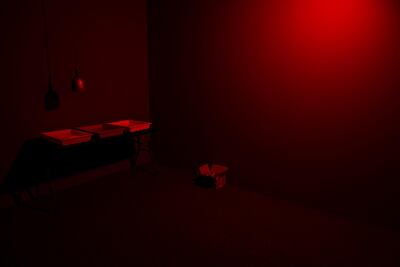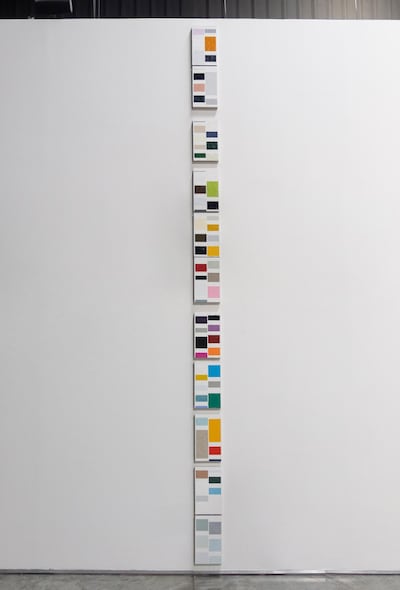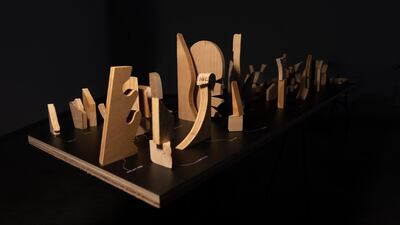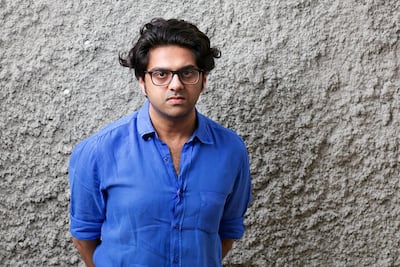Vikram Divecha has a tendency to bring out the hidden or the overlooked. His artistic process involves finding invisible systems and highlighting them in new, abstract ways. Take for example his Road Markings series (2017-2018), where Divecha asked RTA workers in charge of painting roads to create similar lines and shapes on cardboard. He hung up the resulting works in a gallery, transforming these quotidian urban markings – the aesthetics of which are often ignored in favour of their function – into textured, minimalist forms.
A similar process is repeated in his latest exhibition, which comes at the heels of his graduation from Columbia University, where he completed his MFA in Visual Art. On view at Gallery Isabelle van den Eynde, Towards Opacity features installations, photographs and paintings that attempt to draw parallels between “two distinct apparatuses of capture and display” – the museum and the smartphone.
“I realise that there was something very, very similar in how the museum or the smartphone is a repository of cultural information,” he says. The exhibition title references the visible-invisible border that Divecha continually traverses in his practice, and the show as a whole deals with the act of seeing and the ways in which these two entities affect that experience.
If it sounds like a stretch, it is. The flaw in Divecha’s premise is to link two systems over a singular similarity. While both deal with the act of looking or “receiving an image”, as he puts it, they operate in dissimilar ways for different outcomes.
Towards Opacity's central idea emerged from the artist's frequent visits to New York's Metropolitan Museum of Art, or the Met. He noticed how Gallery 354, an exhibition hall with objects from the Oceanic region of Melanesia, was noticeably darker than the preceding Greek and Roman wing. The shaded windows and dim lighting are set-up to protect the wooden pieces from direct sunlight. When he tried to capture these displays on photographic film, he ended up with nothing but blank images.
In the show, Divecha translates this "failure" into an immersive installation resembling a photography darkroom. Under a glowing red light stands a table with three trays. In one of them, a blank photograph floats in liquid. The artist's voice plays over a speaker, reflecting on the experience and detailing a string of diaristic thoughts such as: "A few years ago, when I first entered Gallery 354, my pupils dilated to adjust to the subdued lighting. This incremental shift in aperture within my eyes did not just bring my vision into awareness, but myself as well. A subtle reminder that I was looking from that narrow window of my subjectivity."

As Divecha continues, my eyes eventually adjust to the darkness and the room begins to take shape. This phenomenon called “dark adaptation” is what the artist wants visitors to experience, a mirroring of his own contemplation on vision. But the work falls short of establishing any firm footing about the limitations of perception conceptually, or even the museological model that the artist hopes to investigate. Even his conclusion about his “narrow window of subjectivity” is shallow, offering nothing groundbreaking from general platitudes – we all see things differently.
He tries to probe into the museological system further in another installation, The relationship between wood and sunlight. Collecting discarded pieces from Columbia University's wood shop, the artist recreates a model layout of the Met's Gallery 354 from memory. Laid out on a table, the pieces are loose, so each rearrangement presents a slightly different iteration. A cheap Ikea lamp beams light on to the 3D maquette. In this way, the artist tries to upend the idea of preservation and injects a sense of improvisation into the rigid museological approach of archiving.

To understand why the work's impact is so minimal, it might help to look at the artist's previous works. In Panel, he borrowed a partition panel from an art fair contractor and displayed it in a gallery before returning to its original function, serving as a wall in a booth during Frieze. For his 2017 installation Train to Rouen, he delayed the French Railway schedule by five minutes to examine how we consume time. In both these cases, Divecha was able to subvert the system while being part of it. In the case of Gallery 354, he remains an outsider.
His series of colour block paintings, Lazy Loading, contend with the unseen, just like his previous Road Markings. The title comes from a programming feature where colour blocks act as placeholders for images when internet connectivity is weak. The paintings on view – installed vertically on the gallery wall to resemble the endless scroll of feeds and web pages – are based on screenshots he took when trying to search for a term on Google images.
Collaborating with painters, he studied the mixing of pigment so as to accurately recreate the colours on canvas. It didn’t work, and though the digital-to-analog approach may not be something new, Divecha’s eye for the overlooked brings to light largely unknown functions in the digital realm, and serves as a reminder for systems that govern our perception.
In these works, Divecha acknowledges the recurring role of failure – failing to see and to recreate. Though Towards Opacity does not fail, it does stumble in many ways. The works feel more like the beginnings of an idea, rather than the examination of one. Even in the apprehensive tone of his audio narration, one can sense how Divecha is still grappling with these concepts. It might have been best to explore them a little more.
Towards Opacity is on view at Gallery Isabelle van den Eynde until March 14. More on www.ivde.net



